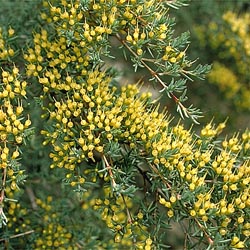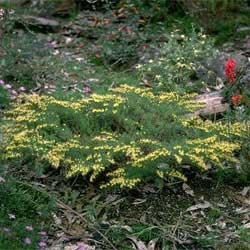Homoranthus flavescens
 |
 |
Homoranthus flavescens A.Cunn. ex Schauer
In the family Myrtaceae the genera Homoranthus and Darwinia are closely related. Homoranthus includes about 28 species and one of them, H. flavescens, is found in northern New South Wales from the coast to the western plains.
 The
foliage of this plant is unusual and distinctive. Silver to blue-grey leaves
are crowded on the upper side of the spreading horizontal branches. Some forms
also have an attractive reddish tinge to the foliage. The leaves are three-sided
to almost cylindrical, about 10 - 15 mm long and 1 mm wide.
The
foliage of this plant is unusual and distinctive. Silver to blue-grey leaves
are crowded on the upper side of the spreading horizontal branches. Some forms
also have an attractive reddish tinge to the foliage. The leaves are three-sided
to almost cylindrical, about 10 - 15 mm long and 1 mm wide.
Branching occurs freely towards the end of the stems. This provides overlapping layers of foliage both at the centre and at the extremities of the plant. The result is a shrub of symmetrical form and a spreading, almost semi-prostrate, habit.
There are some good examples of H. flavescens at the Australian National Botanic Gardens where the plants have reached heights of 40 - 60 cm and widths of 90 - 104 cm.
During winter, flower buds develop in the leaf axils near the ends of the branches. Flowering occurs in late spring and summer, usually between November and February. The individual flowers are quite small, but highlight the branches with a touch of yellow. At close proximity the flowers have an unusual scent. Some birds have been observed in search of nectar or fruit.
Propagation has been carried out using new spring or summer wood, since no seed has been found in Canberra. Without a rooting hormone cuttings have taken one or two months to strike.
Homoranthus flavescens appears to grow best in situations of diffuse light for the most attractive plants are found in semi-shaded locations. In full sun, despite the presence of a mulch, leaf fall occurs and the plants are sparse and slow growing.
When located in a free-draining situation the plant has also grown reasonably on some heavier imported soils. Given the usual cultural requirements of Australian plants, H. flavescens is likely to be a long-lived shrub.
Since most vegetative shoots are located at the ends of branches, the plant is unlikely to respond to severe pruning. Unless dieback occurs, pruning should not be necessary. Minor damage of flower buds by web-building caterpillars is easily controlled by physical removal.
This plant is well suited to sheltered shady positions in a rockery or as an undershrub of taller trees. Interesting effects can be created in group plantings, since the view is equally attractive from the side or above the plant. Grown in a suitable location, H. flavescens provides a combination of foliage colour and symmetrical form that is both unusual and strikingly beautiful.
Text by M S Lodder - ANBG (1979)
Name meaning: Homoranthus flavescensHomoranthus - probably from the Greek, homos, meaning same, and anthos, flower. The reason for the name is obscure; flavescens - from the Latin and meaning yellow, an allusion to the flower colour. |
![An Australian Government Initiative [logo]](/images/austgovt_brown_90px.gif)

